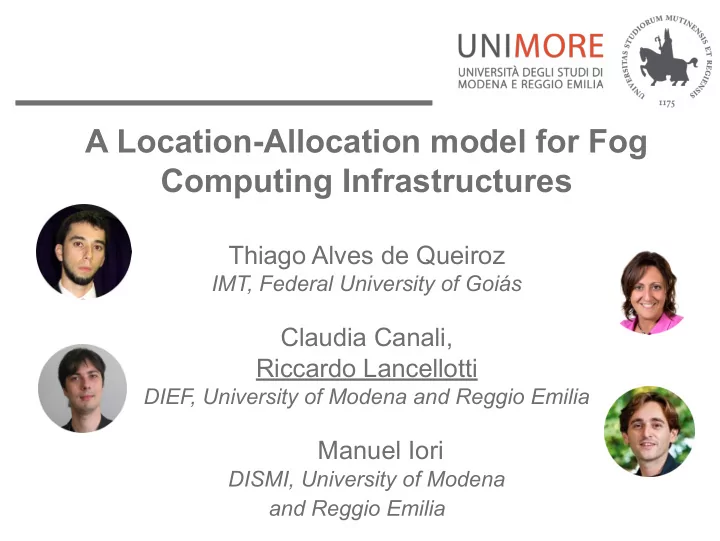

A Location-Allocation model for Fog Computing Infrastructures Thiago Alves de Queiroz IMT, Federal University of Goiás Claudia Canali, Riccardo Lancellotti DIEF, University of Modena and Reggio Emilia Manuel Iori DISMI, University of Modena and Reggio Emilia CLOSER 2020 - May, 7-9 2020
New challenges ● New paradigm: Smart cities large scale sensing applications ● Several fields of application: − Urban applications − Industrial − Automotive − Healthcare − ... ● New scenarios: Cyber-physical systems − Geographically distributed sensors − Huge amount of information produced 2 CLOSER 2020 - May, 7-9 2020
New challenges → New requirements for the infrastructure ● Scalability challenge − Huge amount of data to transfer and process − Geographically distributed systems − Example: CPU- and bandwidth-bound applications ● Low latency challenge − Support for real time applications − Example: latency-bound applications ● Cloud computing is not enough ● (5G alone is not an answer) 3 CLOSER 2020 - May, 7-9 2020
Pros and Cons of Fog ● Benefits of Fog computing ● Scalability: − Pre-processing offloaded to fog nodes − Less strain on Cloud network links ● New open issues: ● Latency: → new Fog infrastructure − Latency-critical tasks − Fog node deployment offloaded to Fog − Sensors-to fog mapping − Fog nodes are closer to ● Joint problem the edge 4 CLOSER 2020 - May, 7-9 2020
Our contribution ● Model for the design of Fog infrastructures − Based on location-allocation optimization problem ● Model decisions: − How many fog nodes do we need? − Which Fog nodes (among a set) turn on? − How to map sensors over fog nodes? ● Double optimization goal − Reduce infrastructure cost − Optimize performance ● Use of SLA constraints 5 CLOSER 2020 - May, 7-9 2020
Notation 6 CLOSER 2020 - May, 7-9 2020
Optimization problem ● Objective function − → Cost for fog nodes − → Response time ● Contributions to response time: − Sensor → Fog avg net delay − Fog → Cloud avg net delay − Fog processing time ● Caveat: definition of λ j ● Main constraints: − Response time < SLA − Load on nodes 7 CLOSER 2020 - May, 7-9 2020
Processing time ● Based on queuing theory − M/G/1 models − Consistent with PASTA theorem ● Non linear model ● Response time as a function of system load 8 CLOSER 2020 - May, 7-9 2020
Scenario definition ● Parameters to describe scenarios ● Average network delay δ ● Network delay / Processing time balance δμ − Scenario CPU bound or Network bound ● System load ρ − Average load of fog nodes 9 CLOSER 2020 - May, 7-9 2020
Experimental scenario Smart City scenario based on ● real example − Italian city (Modena), − ~180,000 inhabitants Traffic monitoring case ● − Sensors on streets − Fog nodes in public buildings − LoRa connections Evaluation using solver (10 min) ● Comparison with: ● (Ideal lower bound, − Continuous model (no bool) used as baseline comparison) − Simplified model (E i =1) 10 CLOSER 2020 - May, 7-9 2020
Experimental results Obj 1 divergence [%] Obj 2 divergence [%] Simplified Model Proposed Model 11 CLOSER 2020 - May, 7-9 2020
Conclusions Challenges of Fog computing ● − Selection of fog nodes and mapping of sensors Contribution: proposal of a model ● − Based on location-allocation optimization problem − Dual objective function − Non linear problem Validation of the model ● − Focus on a realistic scenario − Wide range of parameters considered Open issues ● − Heuristics (GA, Variable Neighborhood Search) − Dynamic scenarios 12 CLOSER 2020 - May, 7-9 2020
A Location-Allocation model for Fog Computing Infrastructures Thiago Alves de Queiroz IMT, Federal University of Goiás Claudia Canali, Riccardo Lancellotti DIEF, University of Modena and Reggio Emilia Manuel Iori DISMI, University of Modena and Reggio Emilia CLOSER 2020 - May, 7-9 2020
Recommend
More recommend